An Illustrated Guide to Shot Placement on White-tailed Deer
As an artist, I’ve spent my entire career studying the external anatomy of the deer I paint. As a bowhunter, I’ve spent those same years studying the internal anatomy of the deer I hunt. It’s crucial to understand the anatomy of a white-tailed deer to make clean shots and quick recoveries. In my latest whitetail print, The Anatomy & Physiology of the White-tailed Buck, I spent month’s researching and drawing the finer points of deer anatomy to give the hunter a better look at what’s inside of North America’s most popular big-game animal. Here's what I learned:

BROADSIDE
One of the easiest angles to draw, and by far the best angle to shoot. For both gun and bow hunters, the broadside shot presents the largest target to strike the heart and lungs.
The Sweet Spot: The shoulder bones form a forward-facing “V” pocket with clear access to the heart and lungs. Aim straight up the front leg and 1/3 to ½ way up from the bottom of the buck. Aim higher on the body when shooting from a tree stand.

QUARTERING AWAY
Shots on cruising bucks will often occur at this angle. Second to the broadside shot, this angle presents great access to the vitals, especially for the bowhunter.
The Sweet Spot: Follow the opposite leg up, aiming 1/3 to ½ way up from the bottom of the buck. Aim higher on the body when shooting from a tree stand. The quartering away shot increases the odds of hitting more than one organ in a single shot (for example, the liver and opposite lung)

The Diaphragm: A little talked about but crucial part of the whitetail’s body is the diaphragm. It separates the heart and lungs from the liver and intestines. When a bullet or arrow cuts through the diaphragm, the buck loses the ability to regulate pressure in the chest cavity, causing his lungs to fail.

QUARTERING TOWARDS
Bucks that sneak in from behind your set up will often present this angle. It’s tempting, but bowhunters should try their best to avoid this one and wait for a better shot as the buck turns.
The Sweet Spot: From the ground, it’s possible to execute a close-range shot in front of the shoulder. From the tree stand though, the scapula, spine and even the buck’s head can come into play.

FACING DIRECTLY AWAY
While a high-energy bullet may pull off the “Texas Heart Shot,” an arrow is unlikely to pass through the buck, resulting in a gut shot at best. At worst, the arrow hits heavy bone or lodges in the pelvis, resulting in a badly wounded animal.

FACING HEAD ON
While a gun or close bow shot from the ground at this angle is possible, the hunter must be careful. A head-on whitetail that turns to bound away at the shot will likely be quartering towards by the time an arrow reaches him. From an elevated tree stand, hitting the vitals at this angle is near impossible, and head or neck shots should always be avoided.

DIRECTLY UNDERNEATH
This angle greatly decreases your odds of hitting more than one vital organ in a single shot, and single lung shots are one of the most difficult shots to diagnose and recover from. Additionally, the buck’s vitals present a smaller target when viewed from above. It’s best to be patient here and try to get a quartering away shot as the buck leaves.

As an artist, it’s my passion to enhance the atmosphere of deer camp. The best way I know to do that is through my best-selling paper prints “The Growth & Maturity of the White-tailed Buck" and “The Anatomy & Physiology of the White-tailed Buck.” The above art and information (plus much, much more) can be found in one place that you can hang on the wall. It’s been an honor to produce them, and I guarantee you they’ll be the talk of hunt camp!
Also check out "Can a Deer Duck an Arrow" for more art on shooting at moving deer, and my popular diagrams on what do to after the shot in "The Waiting Game".
Wishing you a successful deer season,



